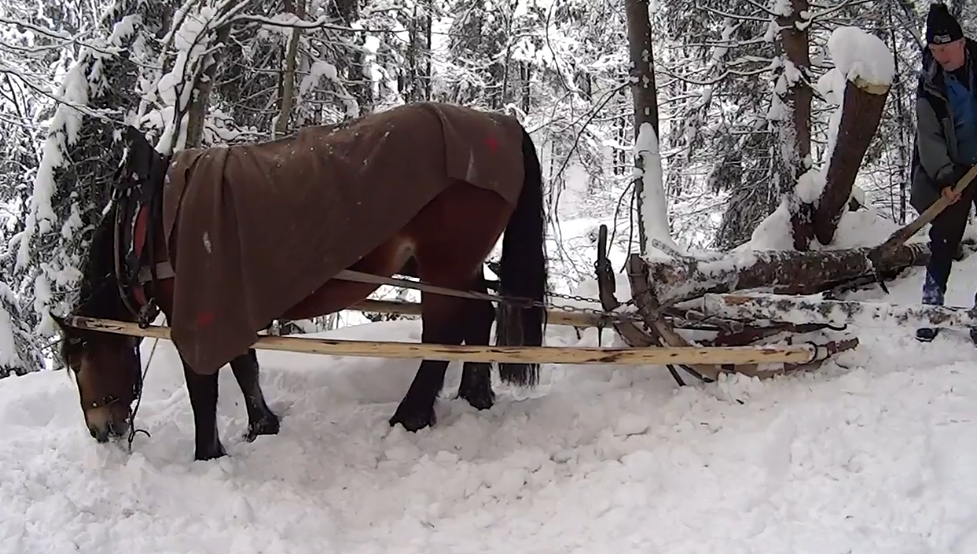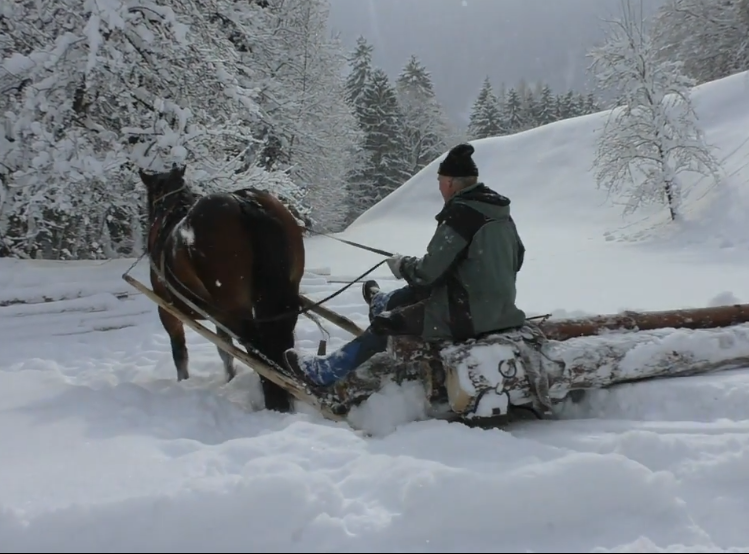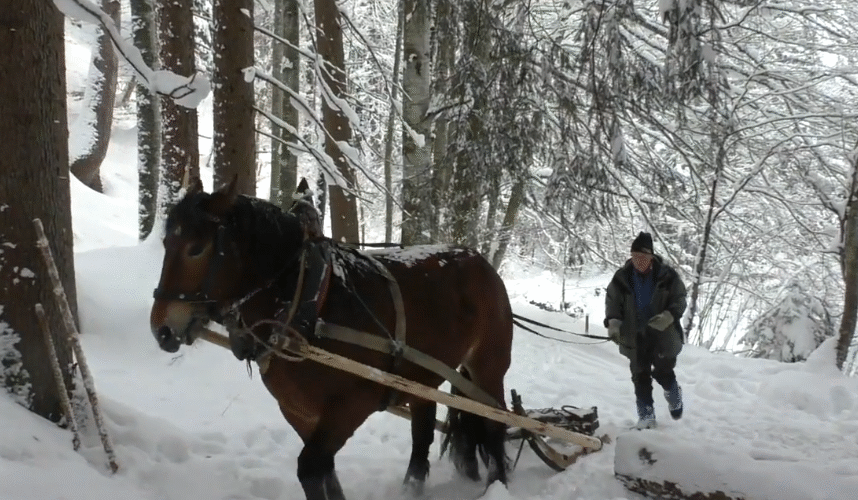In a time when loud machines and heavy equipment dominate the forestry industry, there are still places where the old traditions live on. Deep in the snowy forests of Europe, a calm and quiet scene plays out—a horse named Hasna, harnessed to a simple wooden sled, patiently pulls heavy logs through the snow-covered woods. This timeless practice is called Holzrücken, or horse logging, and it remains a sustainable and respectful way to interact with nature.
A Forgotten Skill in a Modern World
Holzrücken, the traditional method of timber hauling with horses, dates back centuries. Long before mechanized skidders and chainsaws, horses were the primary laborers in the forest. They were strong, intelligent, and gentle—perfect partners for navigating the tight, uneven, and often steep terrain of a woodland.
In this story, we follow Hasna, a powerful and calm draft horse, as she works alongside her handler in the deep snow of a coniferous forest. Wrapped in a brown winter blanket and standing quietly amid the white silence, she embodies the spirit of traditional logging: steady, patient, and deeply connected to the land.
The Bond Between Human and Horse
Logging with a horse is not just about strength—it’s about trust and teamwork. The handler, seen here guiding the sled and adjusting the logs, must communicate clearly with the horse through voice commands, gestures, and sometimes just presence. Hasna doesn’t need a whip or shouting; she responds to calm signals, moving logs with deliberate effort and careful steps through the thick snow.

This relationship is built over time. The horse learns the terrain, the feel of the sled, the balance of the logs. The human learns the horse’s pace, signs of fatigue, and even mood. It’s a true partnership, born from mutual respect.
Sustainable Logging: Why Holzrücken Still Matters
While industrial forestry prioritizes speed and quantity, traditional horse logging provides something that machines cannot: minimal environmental impact. Horses can navigate tight spaces without damaging young trees or tearing up the forest floor. Their hooves leave light prints compared to the deep ruts left by machinery.

In protected forests, nature reserves, or selective thinning operations, horse-drawn logging remains a vital tool. It allows loggers to remove specific trees—often for firewood, timber, or forest health—without disrupting the entire ecosystem. In fact, many foresters and conservationists are rediscovering the ecological benefits of these slower, quieter methods.
A Day in the Life: Hasna at Work
On this wintry day, Hasna begins early. Her handler checks the harness, the sled runners, and ensures the ropes and chains are securely fastened. The snow crunches beneath their boots and hooves as they move from the logging site deeper into the woods.
Once they reach a fallen log, Hasna waits patiently as the handler prepares the load. Then, with a short command, she leans into the harness and begins to pull. The sled glides over the snow, and the log follows—sometimes getting caught, sometimes shifting—but always with Hasna adjusting her steps, her head low and her ears alert.
The work is slow and steady. Breaks are frequent, not only to rest the horse but to listen to the forest, to observe the trees, and to maintain a rhythm that’s in tune with the land rather than fighting against it.
A Vanishing Art Form
While horse logging still exists, it’s a rare and specialized skill. It requires knowledge not only of animals but also of forestry, mechanics, and weather. The number of people who still practice it is small—but growing again, as more people seek sustainable alternatives to large-scale deforestation.
In Germany, Austria, Switzerland, and parts of Eastern Europe, Holzrücken competitions and demonstrations are held to showcase this craft and keep it alive. Young foresters are being trained again in these methods, and horses like Hasna are becoming ambassadors for a greener, gentler way of working in the woods.
The Quiet Beauty of Winter Logging
There is something deeply peaceful about watching a horse like Hasna work in the snow. The only sounds are the creak of wood, the crunch of snow, and the occasional call between human and animal. The forest, wrapped in white silence, becomes a cathedral of nature—a sacred space where work and respect go hand in hand.
Unlike roaring engines, the presence of a horse doesn’t scare wildlife or shatter the tranquility. Instead, it reminds us of how things used to be—and how they still can be, when we choose tradition over convenience.
Teaching the Next Generation
Many people today have never seen a draft horse up close, let alone watched one work. But interest is growing. Schools and nature groups are beginning to invite Holzrücken demonstrations as part of environmental education. Children see not just a powerful animal, but a way of life that honors the land.
Handlers like the one guiding Hasna often speak at these events, sharing stories, techniques, and the philosophy behind their work. They teach that the forest is not just a resource—but a living, breathing world that deserves care, patience, and humility.
Challenges Faced by Modern Horse Loggers
Despite its many benefits, horse logging is not easy work. It’s labor-intensive and requires dedication. Financially, it can be difficult to compete with machines that can harvest in bulk. There’s also limited infrastructure—few schools teach the craft, and few apprentices are willing to dedicate the years required to master it.
Yet, those who continue are passionate. They believe in preserving both the skills and the values behind them. For these horse loggers, success isn’t measured in speed or profit, but in the preservation of forests, the health of their animals, and the satisfaction of a job done with care.
Looking Ahead: Tradition Meets Innovation
While traditional in nature, Holzrücken is finding new relevance in today’s eco-conscious world. Some modern forestry operations are combining horse logging with GPS mapping and selective tree management, creating a hybrid approach that respects tradition while embracing science.
Meanwhile, video content like the image you shared—showing Hasna at work—continues to inspire online audiences. Whether it’s through documentaries, social media, or workshops, the beauty and purpose of horse-powered forestry is reaching new people every day.
